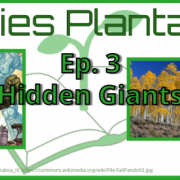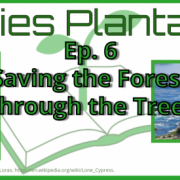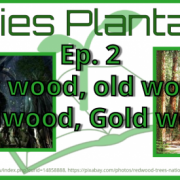Stories Plantarum E1: Vampire Vines Transcript

Episode Description: Welcome to the first episode of Stories Plantarum. Today we talk about an invasive plant from Mars and a real-life plant that that should strike fear in stems all across the plant kingdom.
Prefer to listen to the episode? Links below!
Apple Podcasts (rate and subscribe if you enjoy the show!)
Soundcloud (listen in browser, no programs to download)
Follow on social media!
-Intro Theme “Age of Technology” by DP Music fades in then into background-
Hello and welcome to the first episode of Stories Plantarum, the podcast that compares fictional plants from sci-fi and fantasy to real-life plants that seem out of this world.
I’m your host, Rebecca Hayes, and by day, I’m a budding plant scientist, but by night I’m a sci-fi and fantasy freak. So, I thought why not bring my two great loves together in one spectacular podcast? Here’s how it’s gonna go: first, I’ll tell you about a fabulous fictional plant from the world of sci-fi or fantasy. Then, I’ll compare it to a fascinating real-life plant that can be found somewhere on Earth.
I hope you’re as excited as I am to learn all about the wild and wonderful plants we share our planet with.
– “Space Echo” by Bio Unit Metre fades in-
Let’s dig right in. Stories Plantarum, Episode 1: Vampire Vines.
– “Space Echo” fades into background-
We open this story travelling up, up, and away to a planet not far from home. Mars is the fourth planet from the sun that, according to English author H. G. Wells in his 1898 novel War of the Worlds, gets its red color from an abundant native Martian plant.
This plant was called “The Red Weed” or red creeper by Earthlings and was brought to Earth during a Martian invasion chronicled in the novel. The Martians invaded Earth due to dwindling resources on their home planet and they use humans as fertilizer for the red weed.
Several adaptations of the original novel have been made including a radio drama version by Orson Welles that terrified people around the country who thought that the broadcast was real in 1938, and Stephen Spielberg’s 2005 blockbuster film version starring Tom Cruise.
In the novel, the red weed is both terrestrial and aquatic, and has a different appearance depending on where it grows. On the ground, it grows stubby cactus-like fingers that can get up to 6 feet tall, but grows lily pad-like fronds underwater. The red weed grows incredibly fast in water, which is how it spreads to quickly dominate acres of land around the invasion site.
The Martians use their iconic tripod crafts to harvest humans for their blood, and in the film you can see the tripods spraying empty fields with the human fertilizer and watch the red weed expand and move to feed on the remains. Also, apparently the red weed is edible to humans but, unsurprisingly, has an unpleasant metallic aftertaste.
But luckily for humans, the defeat of the red weed came by way of a microscopic hero: bacteria!
Because the red weed evolved in a Martian environment, its immune system was unadapted to defend itself from Earth’s microbiome. Thanks evolution!
– “Molecules” by Jonah Rapinoe fades in –
The red weed may be fictional, however there is a real-life plant that is just as terrifying to other plants.
– “Molecules” fades down and out-
This plant, called Dodder, is ironically not something your mother would want in her garden. There are over 100 species of Dodder, which is a parasitic vine that feeds on other plants. Its parasitic nature earned it several spooky common names: Strangleweed, Devil’s Guts, Wizard’s Net, and Witch’s Hair. Dodder has low levels of chlorophyll, which makes the parasitism necessary. Chlorophyll is what makes most plants green, so Dodder come in many colors including yellow, orange, pink, or brown. It does have leaves, but they’re so tiny that they’re easy to miss.
– “Molecules” fades back in and up-
I’ll post a picture on twitter, but to me, Dodder vines look like evil silly string sprayed over the host plant.
– “Molecules” fades down and out-
Dodder does have flowers that can be white, pink, yellow, or cream. Dodder’s life cycle begins like most plants: from seed. Once sprouted, the baby Dodder plant must find a host in around 10 days or less, or else it will starve to death. Once a host is located, the Dodder wraps itself around the host and inserts modified aerial roots into the host’s stem. The Dodder then sucks minerals, water, and nutrients out of the plant’s vascular tissue. Eventually, the roots that held the baby plant in the ground will shrivel up and the dodder will be fully supported by the host.
– “Molecules” slowly fades in and up-
Until it sucks the host dry, and then produces seeds, and the cycle continues the following season.
– “Molecules” fades down-
Instead of flailing around haphazardly searching for a host, the Dodder senses volatile scents produced by surrounding plants and grows towards the ones it likes. It has a taste preference: a 2006 study by Runyon et al. at Penn State found that Dodder preferred to grow towards tomatoes instead of wheat. Following that study, an NPR article came out that interviewed a Dodder biologist who described it as – and I’m not making this up – “Probably one of the creepiest plants I know… providing a horrible existence for the host plant. If plants could scream, they’d have the loudest screams when they had dodder attached”.
– “Molecules” fades back up then down-
And if that doesn’t scare you, Dodder also has a taste for important food crops in addition to tomatoes, such as alfalfa, beans, and even hops. This vampire vine may be coming for your beer.
– “Molecules” fades up dramatically and then out-
-Outro music “Business Talk” by DP music fades in-
Alright that’s all I have for this episode of Stories Plantarum. If you enjoyed the show, please like, comment, and subscribe on iTunes or Spotify, and tell your friends to check us out. I’ll be back next episode with more tales from the weird and wacky world of plants.
Stories Plantarum is written and produced by me, Rebecca Hayes. Intro music is “Age of Technology” by DP Music. Also featured are Space Echo by Bio Unit Metre and Molecules by Jonah Rapinoe, both on the Free Music Archive. The outro music is Business Talk by DP Music.
And now for the credits.
Source material for the red weed is H. G. Wells’ 1898 novel War of the Worlds. Background information on the red weed was compiled from the War of the Worlds wiki. Dodder background information was compiled from the Missouri botanical garden’s profile on Dodder, a 2016 Plant Physiology paper by Bianca Stephen and Amanda Rasmussen titled “The physiology of adventitious roots”, the Encyclopedia Britannica entry for Dodder, and the Genus Cuscuta Wikipedia page. The NPR article from which the quote by Colin Purrington was sourced is “Devious Dodder Vine Sniffs Out Its Victims”, written by NPR contributor David Malakoff. The 2006 Science paper by Runyon et al is titled “Volatile chemical cues guide host location and host selection by parasitic plants”.
-“Business Talk” fades back up and out-

Sources:
“Cuscuta.” In Wikipedia, July 2, 2019. https://en.wikipedia.org/w/index.php?title=Cuscuta&oldid=904477778.
“David Malakoff : NPR.” Accessed July 4, 2019. https://www.npr.org/people/4512156/david-malakoff.
“Dodder.” Accessed July 4, 2019. http://www.missouribotanicalgarden.org/gardens-gardening/your-garden/help-for-the-home-gardener/advice-tips-resources/pests-and-problems/weeds/dodder.aspx.
“Dodder | Plant.” Encyclopedia Britannica. Accessed July 4, 2019. https://www.britannica.com/plant/dodder.
“Red Weed.” War Of The Worlds Wiki. Accessed July 4, 2019. https://waroftheworlds.fandom.com/wiki/Red_weed.
Runyon, J. B. “Volatile Chemical Cues Guide Host Location and Host Selection by Parasitic Plants.” Science 313, no. 5795 (September 29, 2006): 1964–67. https://doi.org/10.1126/science.1131371.
“The Physiology of Adventitious Roots | Plant Physiology.” Accessed July 4, 2019. http://www.plantphysiol.org/content/170/2/603.










Leave a Reply
Want to join the discussion?Feel free to contribute!